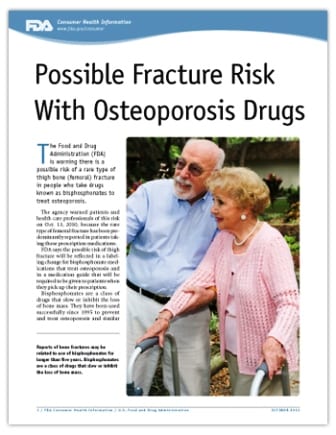Are Treatments for Osteoporosis Sometimes Worse Than the Disease?
Bisphosphonates are widely prescribed medications for the treatment and/or prevention of osteoporosis. The first bisphosphonate (Fosamax, also known as alendronate) for the prevention and/or treatment of osteoporosis was approved for the U.S. market in 1995. Since that time, four bisphosphonate molecular entities (alendronate sodium, risedronate sodium, ibandronate sodium, and zoledronic acid) have been approved for treatment and/or prevention of osteoporosis with dosing intervals that vary from pills taken each day to injections given annually or at two year intervals. These bisphosphonate drugs are sold under various brand and generic names, including:
- Fosamax
- Alendronate
- Boniva
- Actonel
- Aredia
- Zometa
- Aclasta
- Reclast
- Didronel
- Atelvia
- Skelid
For the period of 2005-2009, more than 150 million prescriptions for bisphosphonates were dispensed in the United States, with 5.1 million patients over the age of 55 receiving a prescription for a bisphosphonate drug in the year 2008. It is estimated that a staggering 7% of the entire U.S. population received a prescription for a bisphosphonate for the treatment and/or prevention of osteoporosis.
 Osteoporosis is a systemic skeletal disease characterized by low bone mass and structural deterioration of bone tissue leading to bone fragility and increase risk of fracture. 10 million people in the U.S. have osteoporosis, with women being more often affected. Bisphosphonate products are approved for the treatment and prevention of osteoporosis in postmenopausal women and for the treatment of other bone diseases (such as Paget’s disease).
Osteoporosis is a systemic skeletal disease characterized by low bone mass and structural deterioration of bone tissue leading to bone fragility and increase risk of fracture. 10 million people in the U.S. have osteoporosis, with women being more often affected. Bisphosphonate products are approved for the treatment and prevention of osteoporosis in postmenopausal women and for the treatment of other bone diseases (such as Paget’s disease).
Given the widespread use of these drugs, it should be disconcerting to patients that so many safety issues have come to light over the past few years, such as tissue damage and more:
Atypical Femur Fractures – Patients who have taken bisphosphonate drugs to improve their bone health are actually suffering unusual fractures in their thigh bones (also known as femoral shaft or subtrochanteric femoral fractures). These fractures, which sometimes occur in both legs at the same time, occur when there is damage to the interior structures of the bone caused by long-term use of bisphosphonates.
Disorders of Mineral Metabolism – Use of bisphosphonate drugs has been associated with low serum calcium in blood, a condition also known as hypocalcemia. By binding to skeletal hydroxyapatite and acting to inhibit bone (and therefore calcium resorption), bisphosphonates can effectively limit the available calcium exchange from bone. For this reason, use of these osteoporosis drugs are contraindicated or discouraged in patients with pre-existing hypocalcemia.
Gastrointestinal Disorders – Oral, nitrogen-containing bisphosphonates are known to cause gastroesophageal adverse reactions attributed to mucosal irritation, particularly of the esophagus. Most recently, concerns have been raised regarding esophageal cancer, although this link is still being studied by medical researchers and regulatory authorities such as the FDA.
Musculoskeletal Pain – Muscle joint, and bone pain have been reported with bisphosphonate use. The reported cases have been severe and in some cases incapacitating.
Renal Adverse Events – Concerns regarding an increased risk of kidney toxicity with use of intravenous bisphosphonates has emerged. Adverse events of renal failure requiring dialysis and deaths due to kidney failure have been reported with the use of Reclast. Most of these drug-induced renal injuries occurred in patients with underlying kidney disease or chronic renal insufficiency. Renal compromise has not yet been identified as a safety issue with the other bisphosphonates.
Osteonecrosis of the Jaw – Osteonecrosis of the jaw is a condition that is known to occur in patients exposed to head and neck radiation for the treatment of cancer, but was also linked to use of osteoporosis drugs several years ago. The risks of jaw osteonecrosis are more pronounced with the high-dose IV versions of the bisphosphonates, such as Aredia and Zometa. Any patient who has taken a bisphosphonate drug within ten years of a dental extraction should be first evaluated and precautions taken to avoid infection and minimize the chances of developing jaw osteonecrosis.
Acute Phase Reactions – Bisphosphonate therapy, mainly intravenous bisphosphonates but also higher dose weekly and monthly pill formulations, has been associated with acute phase response symptoms, especially for patients who are new users of the osteoporosis drugs. Patients who are suffering an acute phase response, a type of hypersensitivity reaction initiated by the body’s immune system, may have flu-like symptoms within a few days of ingesting the bisphosphonate but those symptoms should resolve themselves within a week.
Inflammatory Eye Disease – Inflammatory eye disease, such as iritis, uveitis or scleritis has been reported with bisphosphonates use. Currently, inflammatory eye disease is listed as an adverse reaction in product labeling for the bisphosphonate drugs.
It is recommended that you consult with your doctor concerning the safety concerns and possible side effects before taking a bisphosphonates.
Share This


